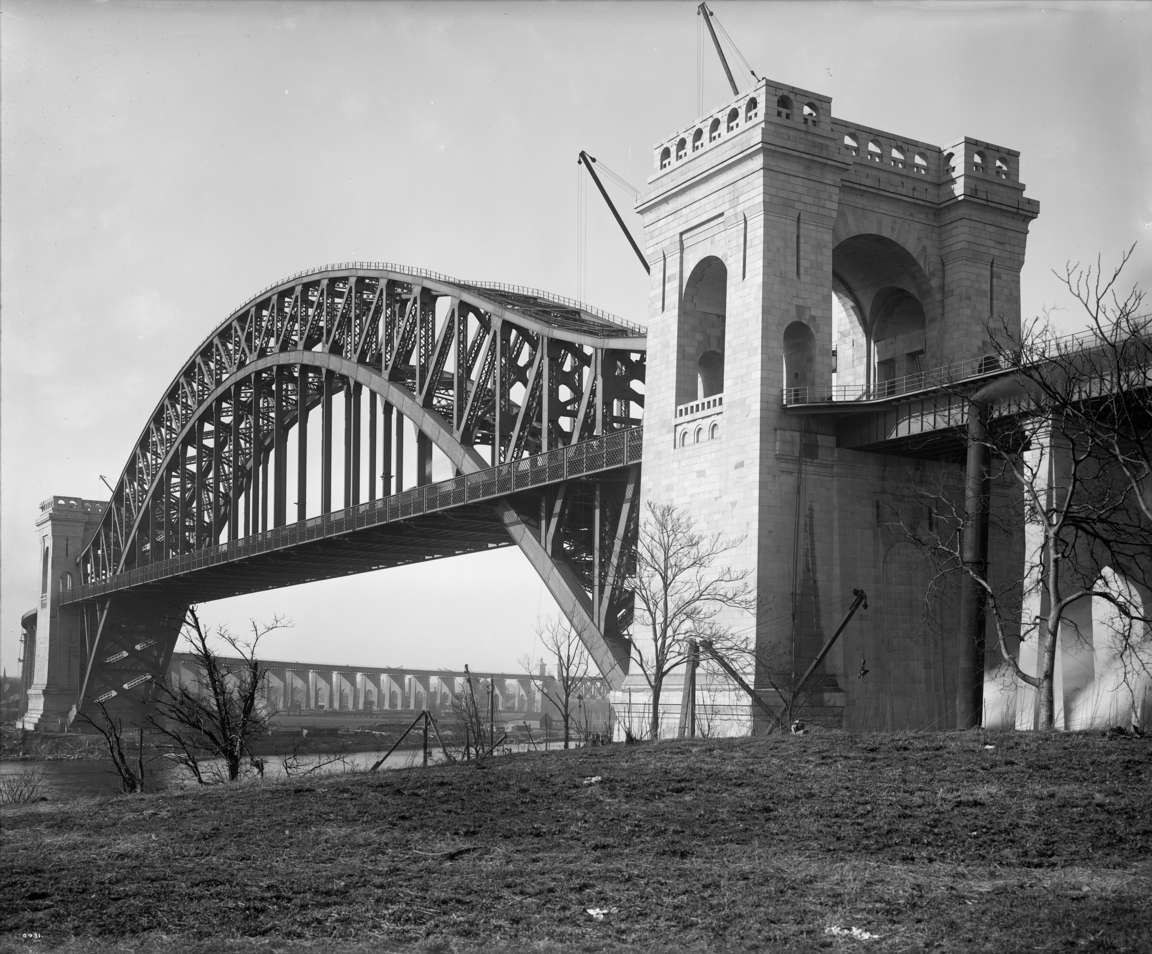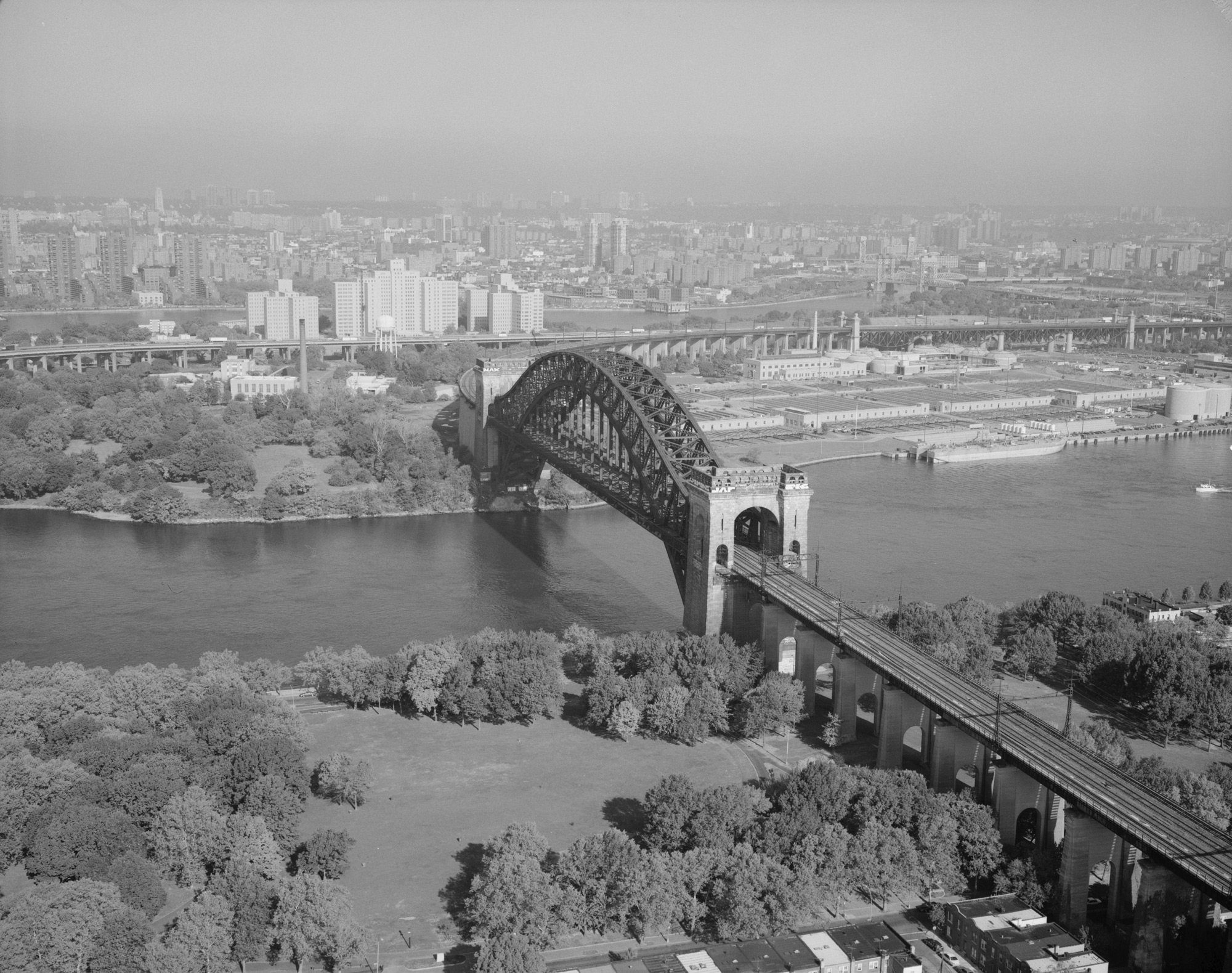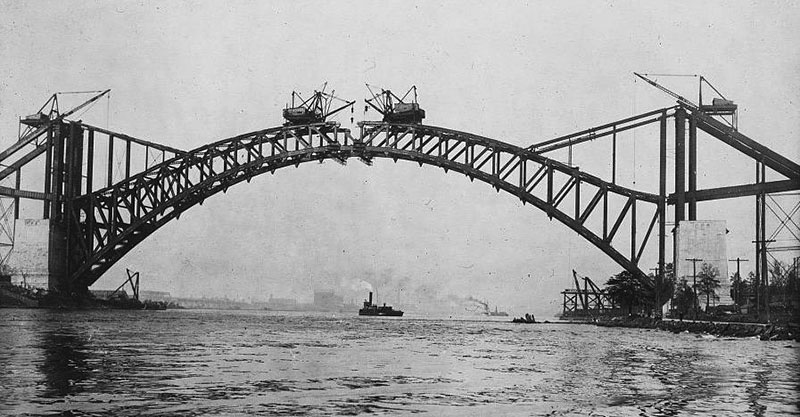Hell Gate Bridge
Last revised: March 12, 2024
By: Adam Burns
Hell Gate Bridge is a railroad bridge connecting the New York City boroughs of Manhattan and Queens. Completed in 1916, it was the world's longest steel arch bridge until 1931.
The project was part of the Pennsylvania Railroad's sweeping upgrades through the greater New York City region during that era, culminating with the completion of Pennsylvania Station in downtown Manhattan in 1910.
During this time the PRR was upgrading infrastructure both above, and below, ground to greatly improve its passenger and commuter services throughout the city and its surrounding buroughs.
The bridge, which was designed by Gustav Lindenthal, is part of the New York Connecting Railroad and is used by Amtrak and freight trains. Its distinctive design has made it a notable landmark in New York City.
 A view of the recently completed Hell Gate Bridge, circa 1916. Photo by the Detroit Publishing Company.
A view of the recently completed Hell Gate Bridge, circa 1916. Photo by the Detroit Publishing Company.Overview
Hell Gate Bridge, which spans the Hell Gate, is another of New York City's many feats of engineering. Officially constructed by the New York Connecting Railroad this company was fully controlled by the Pennsylvania Railroad.
While the bridge's iconic steel-arch span, which crosses the East River, is its endearing feature the entire structure is much larger and stretches over three miles in length from end-to-end. During the PRR-era the bridge was an important link for several different railroads.
At A Glance
Today, the bridge remains an important artery as part of Amtrak's Northeast Corridor and continues to carry freight traffic for CSX, Norfolk Southern, and Providence & Worcester. While the span's name conjures dark thoughts there is actually a rather simple explanation for its designation.
The bridge has direct ties to the PRR's massive Pennsylvania Station project under construction in downtown Manhattan at the time, ongoing since 1902.
It was part of an extension from Long Island (and the PRR-controlled Long Island Rail Road) whereby tracks would head north, pass over the East River via the Hell Gate Bridge and offer a connection with the New York, New Haven & Hartford Railroad for through service into New England (this segment would not open until the 1916 completion of Hell Gate).
History
While Hell Gate Bridge has a quite ominous name it has no symbolic meaning and only describes the region of the East River which the structure spans.
The bridge was originally known as the East River Arch Bridge but the name was changed to better reflect the area in which it was located.
The project had its earliest beginnings dating back to 1892 when then Pennsylvania Railroad president Alexander Cassatt envisioned a bridge to not only connect his western lines with the PRR-controlled Long Island Rail Road but also give the company direct access to New England railroads, notably the New Haven.
Design
Cassatt consulted with engineer Oliver Barnes and reknowned bridge designer Gustav Lindenthal of Austria on a span that would not only span the East River, Ward's Island, and Randall's Island but also the communities of Astoria, Queens and the South Bronx.
Entire libraries could be written on the Pennsylvania Railroad ranging from its history to the different businesses it owned, far, far too much to cover here which is a mere brief history of the railroad.
The Pennsy was an institution to the City of Philadelphia and State of Pennsylvania. For over 100 years the keystone represented the PRR as much as it did the State of Pennsylvania.
 An aerial, black and white photo of Hell Gate Bridge looking north towards the Bronx in 1991. Jet Lowe photo.
An aerial, black and white photo of Hell Gate Bridge looking north towards the Bronx in 1991. Jet Lowe photo.Construction
While Lindenthal had originally hoped to build Hell Gate as a massive suspension bridge he was overruled with the railroad settling on a steel-arch span directly over the East River and Hell Gate.
The entire structure included a bowstring truss design spanning the islands, a fixed truss crossing the Bronx Kills, and finally concrete-constructed viaducts along the rest of the structure.
The bridge would be wide enough to support a four-track main line and would top out, end-to-end, at an incredible 17,000 feet or 3.2 miles. The most famous segment, that which is often photographed, is the segment spanning the East River (or the "East River Arch") which is 1,017 feet in length. In addition, the bridge is 135 feet in height (250 feet above water).
The bridge is also flanked by two, 300-foot masonry approach towers. Its three main spans are also notable for their lengths: the central one measuring 978 feet, and the two adjoining spans at 300 feet each.
Construction of the Hell Gate Bridge began on March 1, 1912. After approximately four years of challenging work, the bridge was successfully opened to the public and began operations on March 9, 1917.
Ironically, the Hell Gate Bridge would have never been built had it not been for Cassatt's vision of Pennsylvania Station. Its was essentially the key link between the PRR and New Haven Railroad, offering travelers direct service from New England into Manhattan.
Following completion, the bridge immediately became an integral part of New York City's transport infrastructure. Its construction improved regional rail services, significantly reducing the journey time to New England, and helping to solidify New York City's position as a major national transport hub.
Operation
The celebrated and central piece of the bridge which spanned the East River used a "spandrel arch" design, similar to bridges which crossed the Rhine River in Germany, which was meant to convey power and strength. A key element in this look were the two massive stone masonry towers that rose well above the bridge's deck.
Today, the bridge remains an important artery for both freight and passenger trains although its track layout has been altered over the years. Today, only three tracks remain with only two of those electrified as one is for freight traffic.
Legacy
Presently, the bridge is owned and operated by Amtrak, America's leading intercity passenger train service. It is a critical component in Amtrak's Northeast Corridor, the busiest railroad in the country, linking principal cities from Washington, D.C., to Boston.
The bridge's design was considered revolutionary at its time, becoming an inspiration for many subsequent structures, including the world-famous Sydney Harbour Bridge in Australia.
Despite the age of the bridge, much of its original construction remains intact. However, over time, the brick masonry towers have experienced some deterioration due to weathering and exposure to elements.
In its early days, the Hell Gate Bridge primarily served freight trains. However, with the decline of the Pennsylvania Railroad, it gradually came to accommodate passenger trains, notably those operated by Amtrak, which assumed control in May, 1971.
Throughout its history, the Hell Gate Bridge has witnessed some minor incidents and mishaps, yet it has stood resilient against the test of time, underlining its sturdy design and high-quality construction.
The Hell Gate Bridge's construction process was captured in a series of photographs offering invaluable insights into early 20th-century engineering and construction techniques. These images remain a remarkable historical record.
The iconic arch of the Hell Gate Bridge has earned it a place in popular culture, with the structure appearing as a backdrop in numerous films and television shows, further augmenting its recognition and significance.
Over the years, there have been several major rehabilitation projects to maintain and ensure the longevity of the Hell Gate Bridge. These have included structural inspections, component replacements, and modernization initiatives to meet contemporary engineering standards.
Despite being primarily a rail transport structure, the Hell Gate Bridge has also played a significant role in enhancing connectivity within the city. It's state-of-the-art design and strategic location successfully bridged the gap between various New York boroughs.
The Hell Gate Bridge remains one of the important contributions of the Pennsylvania Railroad towards the development of the American rail network. Its construction marked a milestone in civil engineering and set new standards for bridge design.
The longevity of the Hell Gate Bridge is testament to the quality of materials used, and the advanced engineering concepts applied in its design and construction. Even after more than a century, it continues to serve its purpose elegantly, reliably connecting the East Coast's major cities.
The Hell Gate Bridge is more than just a passage for trains; it's a symbol of human determination, engineering expertise, and a timeless testament to America's railroad heritage.
In conclusion, since its inception, the Hell Gate Bridge has played a pivotal role in transforming the landscape of New York's transportation network. As it continues to operate, it stands not only as an architectural marvel, but also as an important piece of American history. Its tale of resilience and relevance, even after 100 years, is indeed a tribute to the visionaries it originated from - the Pennsylvania Railroad and Gustav Lindenthal.
SteamLocomotive.com
Wes Barris's SteamLocomotive.com is simply the best web resource on the study of steam locomotives.
It is difficult to truly articulate just how much material can be found at this website.
It is quite staggering and a must visit!

